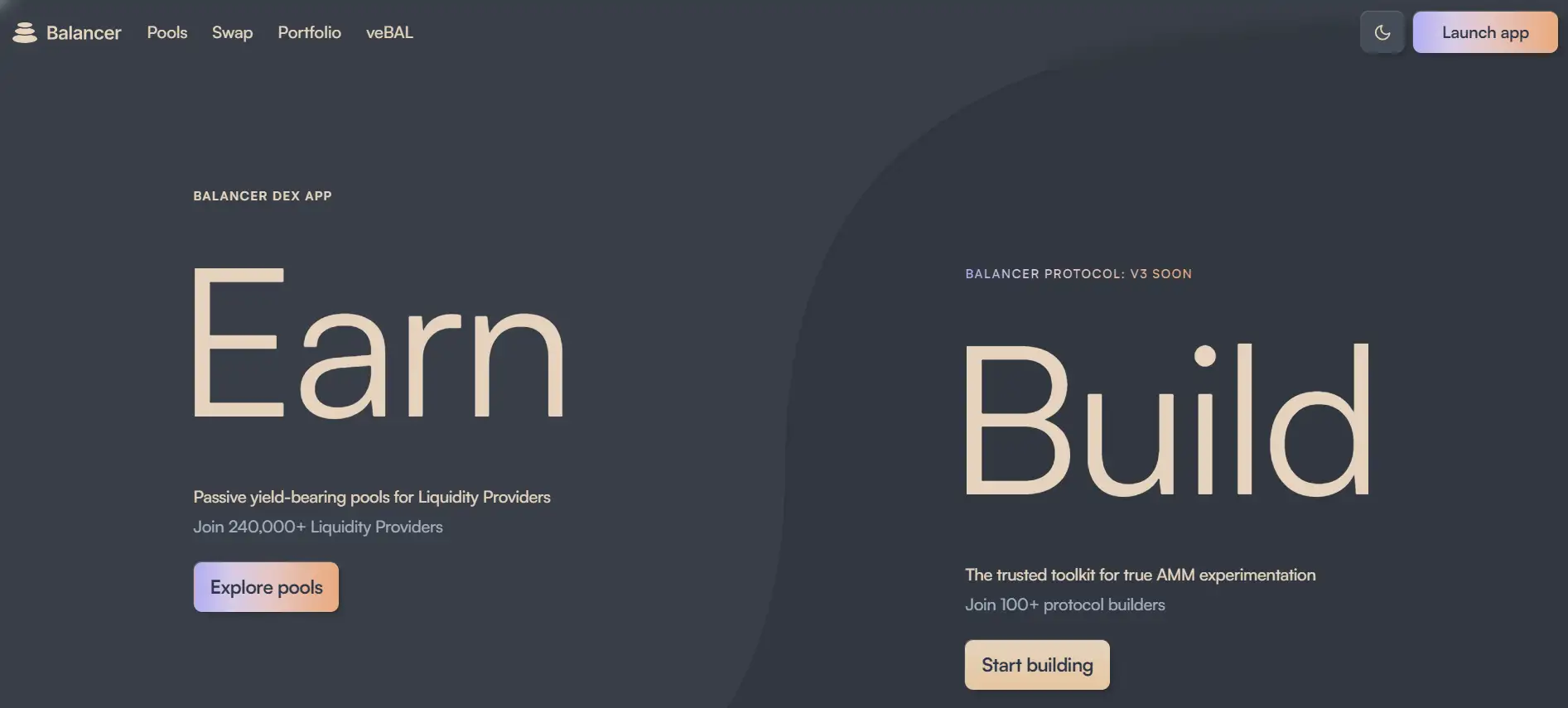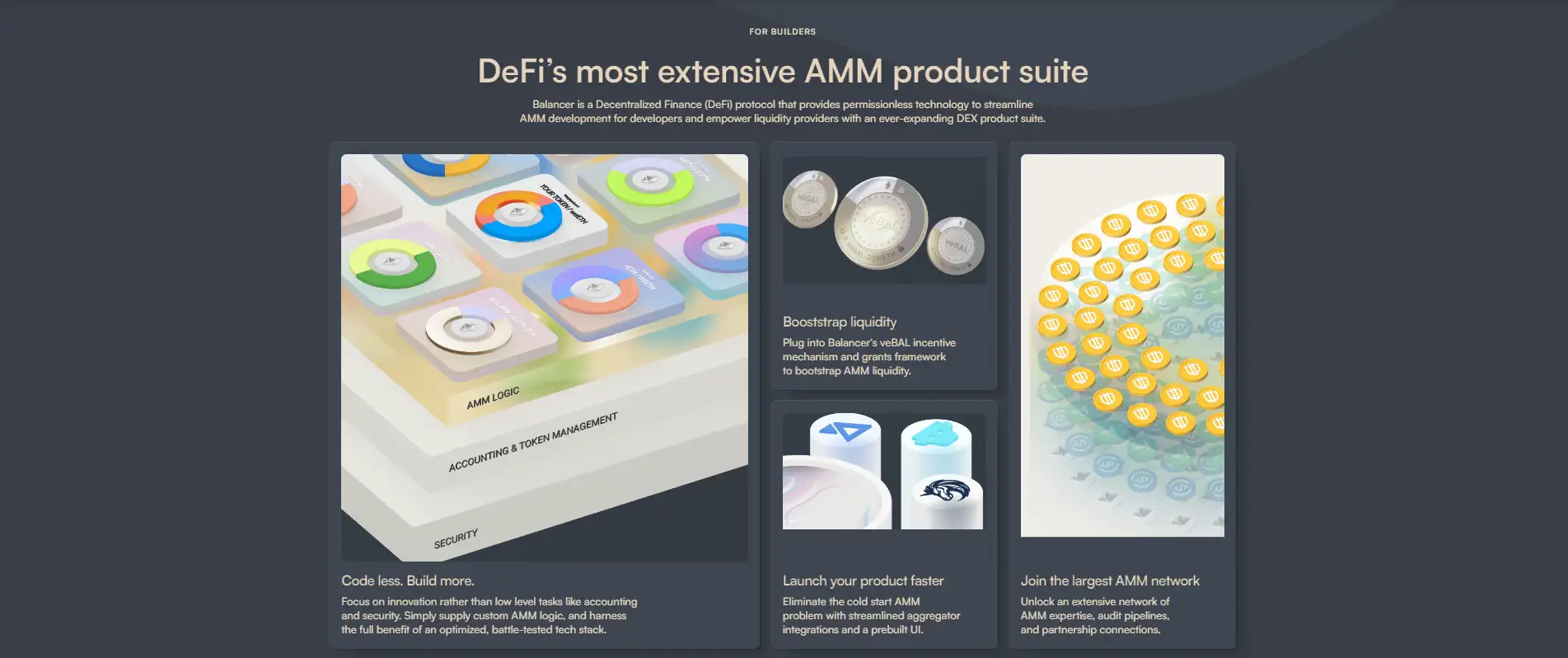About Balancer
Balancer is a cutting-edge decentralized automated market maker (AMM) built on the Ethereum blockchain. It is a core innovation in the decentralized finance (DeFi) ecosystem, enabling users to trade Ether and ERC-20 tokens in a trustless and permissionless manner. Unlike traditional exchanges, Balancer allows users to create customizable liquidity pools with multiple tokens and varying weights, offering a unique solution for portfolio management and automated trading. With this model, users can act as their own portfolio managers, earning fees as traders rebalance their pools through arbitrage opportunities.
The project's mission is to provide a highly flexible and decentralized framework for asset management and trading while maintaining a focus on security, transparency, and user empowerment. By leveraging innovative mathematical frameworks and smart contract technology, Balancer enables efficient token swaps without relying on order books. Its native governance token, BAL, empowers community members to have a voice in shaping the protocol, ensuring that the platform evolves according to the needs of its users. Balancer stands out as a transformative tool in the DeFi industry, offering superior flexibility and functionality compared to its competitors like Uniswap and Curve Finance.
Balancer was launched in March 2020 as an open-source protocol designed to address key challenges in automated portfolio management and decentralized trading. Unlike traditional AMMs, Balancer introduced a novel concept of multi-asset liquidity pools, allowing users to create pools with up to eight tokens and varying weight distributions. This flexibility has positioned Balancer as a preferred choice for portfolio diversification and yield generation in the DeFi space.
The protocol's core innovation lies in its customizable pool structure. Users can define the token ratios, fees, and liquidity depths according to their specific needs. This feature enables a high degree of versatility, attracting a broad range of users, from retail traders to institutional investors. The platform's governance model, powered by the BAL token, further ensures decentralization by giving stakeholders a voice in protocol decisions.
Since its inception, Balancer has achieved several milestones, including integration with major DeFi platforms, partnerships with projects like Aave, and support for Layer 2 scaling solutions. Its competitors, such as Uniswap and Curve Finance, offer similar services but lack Balancer’s advanced features, such as multi-token pools and dynamic fee adjustments.
Balancer’s focus on innovation and user empowerment has solidified its position as a leading player in the DeFi industry. Its robust security measures, including regular audits and community-driven governance, ensure a trustworthy and user-friendly platform for all participants.
- Customizable Liquidity Pools: Users can create liquidity pools with up to eight tokens and variable weight distributions, enabling unparalleled flexibility in portfolio management.
- Decentralized Trading: Trades are executed on-chain in a trustless manner, eliminating the need for intermediaries and reducing costs.
- Earn Trading Fees: Liquidity providers earn fees from traders who use their pools, incentivizing active participation and enhancing platform liquidity.
- Governance with BAL: BAL token holders participate in protocol governance, influencing key decisions and upgrades.
- Advanced Features: Dynamic fee adjustments and multi-token pools set Balancer apart from competitors like Uniswap and Curve Finance.
- Security: Regular audits and robust smart contract frameworks ensure a secure trading environment.
- Visit the official Balancer website.
- Set up a crypto wallet compatible with Ethereum, such as MetaMask or WalletConnect.
- Fund your wallet with Ether (ETH) to cover transaction fees. You can buy ETH on exchanges like Coinbase or Binance.
- Connect your wallet to the Balancer app.
- Choose from the available liquidity pools or create your own pool to start earning fees.
- For governance participation, buy BAL tokens on exchanges like Binance or Kraken and stake them to vote on proposals.
Balancer FAQ
On Balancer, users can create their own liquidity pools with specific token ratios and fee structures. This gives them control over their assets and the ability to earn fees from traders who rebalance their pools, acting as automated portfolio managers.
Balancer’s multi-token pools allow up to eight tokens with variable weight distributions. This means users can hold diverse portfolios in a single pool while earning trading fees, which reduces risks compared to traditional two-token pools found on platforms like Uniswap.
The BAL token enables community-driven governance on the Balancer protocol. Token holders can vote on proposals, such as protocol upgrades or fee adjustments, ensuring the platform evolves based on user needs and stays decentralized.
Balancer mitigates impermanent loss by allowing customizable token weights in pools and dynamic fee adjustments. These features reduce exposure to volatile market conditions and provide a safer environment for liquidity providers.
Dynamic fees adjust automatically based on market conditions. They incentivize liquidity providers by increasing fees during high volatility and reducing fees during stable periods, ensuring users receive optimal value for their participation.
You Might Also Like












